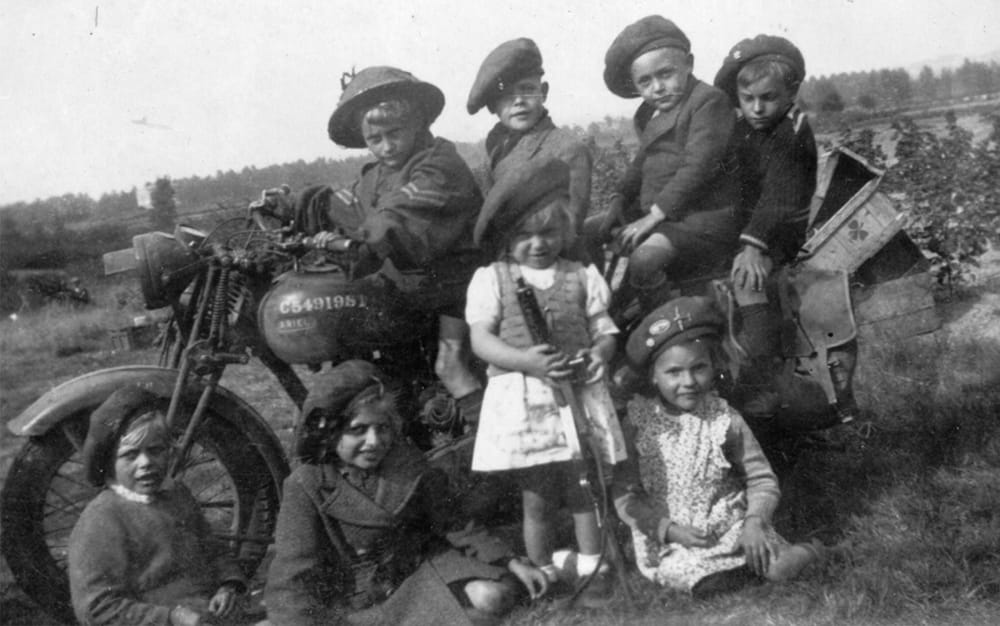Hi All,
I have a doubt about side stand in my Norton 16 H. My model doesnot have sidestand bracket to fix the side stand in the rear. Was this bracket available only in earlier models.
Kindly throw some light on this.
. 🍻 Cheers All
Muthu
email (option): a.muthukumr@gmail.com
On early WD 16H's the extra lug wasn't yet produced as part of the frame, so an extra clamp on lug was made. The original footrest lug is used for the field stand and the other lug sits just in front for the foot rest. I managed to borrow an original and got some cast in bronze. A friend did the machining. All gone a long time ago now. Ron
PS. See the special extended lower bolt that sits under the brake torque arm to stop the lug twisting on the frame tube.


email (option): ronpier@talk21.com
Hi Ron,
. Thanks a lot for your time. Is it possible to get the sidestand and the lower bolt to fix in my 16 H.
🍻Cheers All
Muthu
email (option): a.muthukumr@gmail.com
To add a little background information, prior to the outbreak of war in 1939, it was expressly forbidden to carry a passenger on a British Army motorcycle and therefore no pillion facilities were fitted. Norton though supplied frames with both footrest lugs in place and the left hand one was used for the 'Field Stand'.
Experience during the campaign in France and Flanders in May 1940 with roads often blocked and no other traffic possible showed that it was in fact extremely useful for officers particularly to be carried on motorcycles and the rules were altered. It does mean though that WD 16H models made between 1936 and late 1940 had no extra stand lug.
The Norton field stand is in fact a pretty dreadful thing. It pivots too low and is too far back meaning that there is almost no weight on the rear wheel. Even on soft ground and with the machine in gear, there is a good chance that the machine will fall over.
Hi Rik,
Thank you for your response information shared. I need to search for the extra lugs to fit the field stand in my Norton.
Cheers 🍻 All
Muthu
email (option): a.muthukumr@gmail.com
PS. See the special extended lower bolt that sits under the brake torque arm to stop the lug twisting on the frame tube.
email (option): keithchandler@clistandchandler.co.uk
I think you are right about that Keith. I had a NOS pair of Royal Enfield handlebar claps where the saddle clap part that holds the handlebar needed to be cut free of the main casting. Ron
email (option): ronpier@talk21.com
Gents,
I think the initial question has been answered in a bit confusing manner.
The gentlemen asks about the sidestand but gets an answer on the pillion footrest.
If it is an early (pre 1941, change came late 1940) military frame, there normally is one lug close to the rear axle on the near-side and one on the off-side.
On military machines the near-side lug is much biefier/robust than the pillion footrest lug on the other side.
On the later frames a second lug (less biefier/robust) was brazed to the lower chain stay to serve the pillion footrest in front of the sidestand lug.
The part shown by Ron was an interim measure to be able to mount a pillion footrest on an earlier frame, specificaly not for mounting a sidestand.
One distinct indicator between civilian and military frame I am always looking for is that biefier lug on the near-side.
Unless a previous owner filed it down to civilian dimensions it is an absolute indicator for a military frame.
Muthu may in this case not have noticed that he already has the field stand lug and has unknowingly used it as a foot rest lug.
Not the first time I come across this.
Cheers,
Rob
email (option): wd16h@telfort.nl
OK Rob I never noticed that the nearside lug was beefier. (I'll look tomorrow) I just assumed as Rik suggested that they just utilized the nearside footrest lug for the side stand.......If that lug was intended for that use, why did they fit just the offside footrest lug??
Ron
email (option): ronpier@talk21.com
PS I just looked and the N/S lug is heavier......Again, why just one footrest? Ron
email (option): ronpier@talk21.com
Ron,
Funny that you never saw it, you are one of many (most actually)!
They only did that nearside because it was specially intended for the sidestand!
Pillion lug on right hand side is indeed an unsolved question that has been asked everytime I attend people on the beefier lug.
I really do not know the reasoning behind it. My 1937 frame is also built like this so I think it is not time specific/limited.
There is however one option and that might be that Norton also added a beefier lug on civilian machines but I have never seen it like that.
The later pillion lug is a mirror image of the right hand one so they did have the castings.
Norton appears to be an inscrutable company!
Cheers,
Rob
email (option): wd16h@telfort.nl
Pre-War India Office machines had two lugs on the left hand chainstay. For some odd reason, the British Army in India was allowed to carry pillion passengers.

